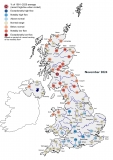Submitted by Lucy Barker on
June was generally an unsettled month and, while there were warmer and drier periods, much of the month was notably cool and, for large parts of the country, very wet, with persistent and heavy rainfall more characteristic of the winter half-year. The most exceptional rainfall occurred over low-lying areas of central and eastern England, leading to some notably high peak river flows and localised (but severe and damaging, particularly in Lincolnshire) flooding. However, June rainfall totals and river flows were not as outstanding as in other recent very wet summers (e.g. 2007 and 2012). The wet June contrasts markedly with previous months and the rainfall has reduced soil moisture deficits (SMDs) across England, bringing short-term relief from agricultural and environmental stress. The long-term impact of the persistent dryness is still evident in southern and eastern England. Groundwater levels continued to decline in the Chalk and were notably low across East Anglia and, while June river flows were typically normal or above, recessions recommenced in late June into early July. Reservoir stocks were moderately above average at the national scale, with only two impoundments (in the south west) having stocks around 10% below average at month-end. Overall, the water resources situation has improved and the recent rainfall has diminished the likelihood of water resources pressures in summer 2019. However, July began very dry and current outlooks for the next three months suggest a continuation of below normal flows and groundwater levels in parts of eastern England, so agricultural and environmental impacts remain a risk through to the autumn.



